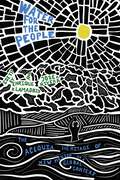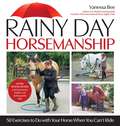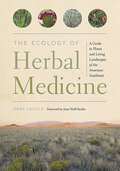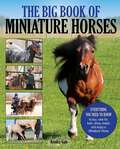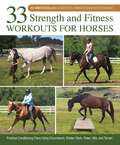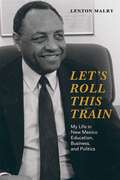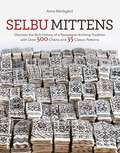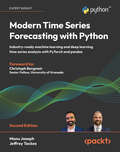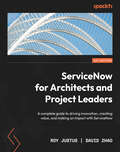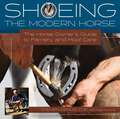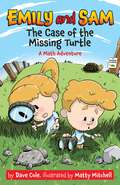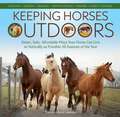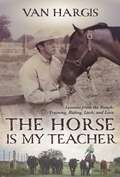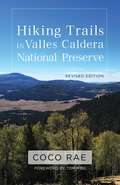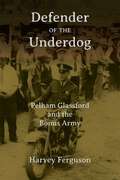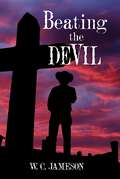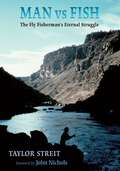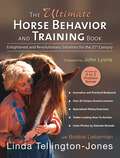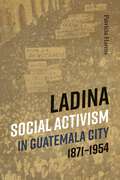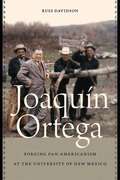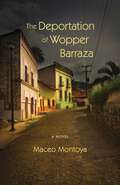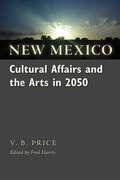- Table View
- List View
Water for the People: The Acequia Heritage of New Mexico in a Global Context (New Century Gardens and Landscapes of the American Southwest)
by Enrique R. Lamadrid and José A. RiveraWinner of the Historical Society of New Mexico Fray Francisco Atanasio Domínguez Award Winner of the 2024 New Mexico-Arizona Book Award for History Anthology Water for the People features twenty-five essays by world-renowned acequia scholars and community members that highlight acequia culture, use, and history in New Mexico, northern Mexico, Chile, Peru, Argentina, Spain, the Middle East, Nepal, and the Philippines, situating New Mexico&’s acequia heritage and its inherent sustainable design within a global framework. The lush landscapes of the upper Río Grande watershed created by acequias dating from as far back as the late sixteenth century continue to irrigate their communities today despite threats of prolonged drought, urbanization, private water markets, extreme water scarcity, and climate change. Water for the People celebrates acequia practices and traditions worldwide and shows how these ancient irrigation systems continue to provide arid regions with a model for water governance, sustainable food systems, and community traditions that reaffirm a deep cultural and spiritual relationship with the land year after year.
Rainy Day Horsemanship
by Vanessa BeeClever ways to improve your horse's performance when groundwork is all you can do.There are dozens of reasons you might not be able to ride your horse. Weather can have an impact on your riding and training choices, sometimes keeping you out of the saddle, as can an injury to you or your horse, or changes in lifestyle or horsemanship goals. But time not riding does not need to be time wasted, explains trainer and popular instructor Vanessa Bee. As Founder of the International Horse Agility Club, Bee brings to the stable a unique set of skill-building techniques and exercises that anyone can use to better understand how the horse moves and how to influence that movement, resulting in better behavior on the ground, improved performance under saddle, and strengthened connection whenever and however you and your horse interact.Bee's degree in education and experience as a teacher, as well as a horse trainer and riding instructor, informs the way she presents her easily achievable lessons that you can do right in the barn with limited equipment, including:Exercises to help you get to know your horse better.Safe handling techniques.Specific ways to build a trusting relationship.Fun games and ideas for engaging the horse's mind and body.Challenges that test willingness, balance, and focus.With five foundation skills providing a clear place to start, and step-by-step instructions for 50 individual tasks and activities on the ground that not only engage both horse and rider but build toward immense rewards under saddle, this vibrantly illustrated book delivers for riders of all ages and abilities. Whether your goals are better dressage scores or quiet trail rides, or just safe and fulfilling time spent in the company of horses,Rainy Day Horsemanshiphas the positive steps you can take, starting today, whatever the season, whatever the weather.
The Ecology of Herbal Medicine: A Guide to Plants and Living Landscapes of the American Southwest
by Dara SavilleThe Ecology of Herbal Medicine introduces botanical medicine through an in-depth exploration of the land, presenting a unique guide to plants found across the American Southwest. An accomplished herbalist and geographer, Dara Saville offers readers an ecological manual for developing relationships with the land and plants in a new theoretical approach to using herbal medicines.Designed to increase our understanding of plants&’ rapport with their environment, this trailblazing herbal speaks to our innate connection to place and provides a pathway to understanding the medicinal properties of plants through their ecological relationships. With thirty-nine plant profiles and detailed color photographs, Saville provides an extensive materia medica in which she offers practical tools and information alongside inspiration for working with plants in a way that restores our connection to the natural world.
Big Book of Miniature Horses
by Kendra GalePet, show-ring competitor, pasture companion, driving partner, patient therapy horse—the Miniature Horse does it all. But whether you dream of winning ribbons or just hanging out, it is vital to have a solid understanding of safe handling and proper stabling; grooming needs and feeding requirements; general care and management essentials; special health and wellness concerns; and basic training how-tos. In these pages experienced Miniature Horse breeder Kendra Gale of Circle J Miniature Horses provides the most complete Miniature Horse resource available. You not only learn the ins and outs of making a Miniature Horse a part of your life, you gain invaluable professional insight when it comes to buying and breeding, registering and showing, training and handling, and so much more.
33 Strength and Fitness Workouts for Horses
by Jec Aristotle BallouThe go-to reference for riders and trainers aiming to improve equine conditioning in ways that are strategic, engaging, and fair to the horse.For just about everything we do with horses—from trail riding to top level competition—a healthy state of fitness is key to both performance and longevity. Every horse will go better for longer if his mind and body are well prepared for the &“ask.&”When it comes to improving fitness, whether for humans or animals, the success of an exercise relies on dosage. How an exercise is applied, the duration and frequency of execution, and the weekly schedule within which it is incorporated determine its impact on fitness.Equine training and conditioning expert Jec Aristotle Ballou has now provided a book that takes the guesswork out of fitness gains. It clarifies how long and frequently to do a particular exercise and provides guidance in how to combine it with others for best results. The result is maximized health and athleticism in the horse.The 33 workouts in these pages help accomplish the performance goals that many riders strive for but fall short of reaching stronger, more agile, and more balanced horses. They do this by circumventing the tension, both physical and mental, that often spoils conditioning attempts made within a discipline-specific or skill-based training session. By providing the right amount of stimulus while avoiding boredom, fatigue, and habituated neuromuscular patterns, Ballou's workouts lead to positive physiological gains. Her plans include:Ways to measure a horse's current fitness.Guidelines for active and passive rest.Basics for stretching, warming up, and improving mobility.Unique groundwork that keeps both you and your horse engaged.Hill hikes and terrain tests with multiple benefits.Suggested schedules for basic fitness goals, as well as special considerations for young horses and trail riders.With easy-to-follow step-by-step instructions and clear illustration, this book is a fundamental piece of any conscientious rider's training plan and a key component to keeping horses performing happily for more years of their lives.
Let's Roll This Train: My Life in New Mexico Education, Business, and Politics
by Lenton MalryThis inspiring memoir chronicles Lenton Malry&’s journey from segregated Louisiana to a distinguished career in public service in New Mexico. Malry worked as a teacher on the Navajo Reservation, as a public school administrator in Albuquerque, and as a commissioner in Bernalillo County. He was also the first African American elected to the New Mexico state legislature and the first African American to earn a PhD in education from the University of New Mexico.
Selbu Mittens
by Anne BardsgardThe ultimate compendium for any Norwegian mitten enthusiast, this gorgeous and inspiring resource was produced in conjunction with a one-of-a-kind exhibition of gloves and mittens from Selbu at the Sverresborg Trøndelag Folkemuseum. A thoroughly researched and illustrated account of the rich history of Selbu patterning—instantly recognizable for its dramatic contrasts and intricate motifs—covers the development of the designs themselves, and the essential role these knitted accessories have played in the cultural and economic development of the Selbu region. Then, dive into pages upon pages of over 500 colorwork charts, organized according to the source of their inspiration, from classic stars, snowflakes, and flowers to elk, spiders, and coffee beans. Complete patterns are included for 35 mittens and gloves from the original museum collection, accompanied by short biographies of the original designers—or choose from an overflowing selection of motifs for palms, thumbs, cuffs, and even patterned edging techniques for joining around the hand, to create endlessly fascinating combinations.
Dressage Seat
by Anja BeranWith stunningly beautiful photographs and clear descriptions, classical dressage authority Anja Beran breaks down the physical requirements of the rider's seat on the horse, as well as its responsibilities during various movements—from the gaits and paces to lateral work, lead changes, piaffe, passage, and pirouettes. Beran provides a unique perspective on the use of breath when riding, citing the recommendations of a classically-trained opera singer who regularly works with Beran and her riding students to develop their deep breathing skills. &“A relaxed seat,&” Beran says, &“is never possible with restricted breathing.&” In addition, she explores the need for an improved inner attitude in order to truly refine your seat on a horse. Fear, stress, and tension all interfere with your ability to focus on the horse and connect with him during the time you are together. Simple practices can help open and calm the mind, and over time, contribute to an overall better outlook and enhanced physical capacity. In the second half of the book, Beran is joined by her personal physiotherapist and dance teacher for an in-depth look at human anatomy and how it functions in conjunction with the horse. Practical exercises give readers easy ways to improve mobility, strength, stability, coordination, perception, and overall posture, with superb results.
Modern Time Series Forecasting with Python: Industry-ready machine learning and deep learning time series analysis with PyTorch and pandas
by Manu Joseph Jeffrey TackesLearn traditional and cutting-edge machine learning (ML) and deep learning techniques and best practices for time series forecasting, including global forecasting models, conformal prediction, and transformer architecturesKey FeaturesApply ML and global models to improve forecasting accuracy through practical examplesEnhance your time series toolkit by using deep learning models, including RNNs, transformers, and N-BEATSLearn probabilistic forecasting with conformal prediction, Monte Carlo dropout, and quantile regressionsPurchase of the print or Kindle book includes a free eBook in PDF formatBook DescriptionPredicting the future, whether it's market trends, energy demand, or website traffic, has never been more crucial. This practical, hands-on guide empowers you to build and deploy powerful time series forecasting models. Whether you’re working with traditional statistical methods or cutting-edge deep learning architectures, this book provides structured learning and best practices for both. Starting with the basics, this data science book introduces fundamental time series concepts, such as ARIMA and exponential smoothing, before gradually progressing to advanced topics, such as machine learning for time series, deep neural networks, and transformers. As part of your fundamentals training, you’ll learn preprocessing, feature engineering, and model evaluation. As you progress, you’ll also explore global forecasting models, ensemble methods, and probabilistic forecasting techniques. This new edition goes deeper into transformer architectures and probabilistic forecasting, including new content on the latest time series models, conformal prediction, and hierarchical forecasting. Whether you seek advanced deep learning insights or specialized architecture implementations, this edition provides practical strategies and new content to elevate your forecasting skills.What you will learnBuild machine learning models for regression-based time series forecastingApply powerful feature engineering techniques to enhance prediction accuracyTackle common challenges like non-stationarity and seasonalityCombine multiple forecasts using ensembling and stacking for superior resultsExplore cutting-edge advancements in probabilistic forecasting and handle intermittent or sparse time seriesEvaluate and validate your forecasts using best practices and statistical metricsWho this book is forThis book is ideal for data scientists, financial analysts, quantitative analysts, machine learning engineers, and researchers who need to model time-dependent data across industries, such as finance, energy, meteorology, risk analysis, and retail. Whether you are a professional looking to apply cutting-edge models to real-world problems or a student aiming to build a strong foundation in time series analysis and forecasting, this book will provide the tools and techniques you need. Familiarity with Python and basic machine learning concepts is recommended.
ServiceNow for Architects and Project Leaders: A complete guide to driving innovation, creating value, and making an impact with ServiceNow
by Roy Justus David ZhaoGain insight and strategic advice for driving value in your organization with this practical guide that condenses a decade of ServiceNow wisdom into the must-know essentials for impactful deploymentsKey FeaturesFocus on what to do when shaping and leading a ServiceNow journeyExplore strategies for making your projects impactful and valuableGuidance for leaders at every level to maximize return on their investments in ServiceNowBook DescriptionServiceNow is the leading enterprise service management platform that enables the effective management of services in a modern enterprise.In this book, you'll learn how to avoid pitfalls that can challenge value realization, where to focus, how to balance tradeoffs, and how to get buy-in for complex decisions. You'll understand the key drivers of value in ServiceNow implementation and how to structure your program for successful delivery. Moving ahead, you'll get practical guidance on the methods and considerations in securely using ServiceNow. You'll also learn how to set up a multi-instance environment including best practices, patterns and alternatives in the use and maintenance of a multi-instance pipeline. Later chapters cover methods and approaches to design processes that deliver optimal ROI. Further, you'll receive tips for designing technical standards, designing for scale, ensuring maintainability, and building a supportable instance. Finally, you'll focus on the innovative possibilities that can be unlocked in a ServiceNow journey which will help you to manage uncertainty and claim the value of being an early adopter.By the end of this book, you'll be prepared to lead or support a ServiceNow implementation with confidence that you're bringing not only a solution but also making an impact in your organization.What you will learnUnderstand the key drivers of value in ServiceNow implementationStructure your ServiceNow programs for successful deliveryDiscover methods and tools for securely using ServiceNowSet up a multi-instance environment with best practices and patternsArchitect and lead the deployment of AI capabilities in ServiceNowBuild innovative experiences using NLU, virtual agents and the Now Experience FrameworkWho this book is forThis book is for architects, consultants and project leaders looking to drive value by applying ServiceNow effectively and efficiently. Platform administration or development experience is useful but not necessary to get the most out of this book. However, some familiarity with the modules and features of ServiceNow is expected.
Shoeing the Modern Horse
by Steven Kraus Katie NavarraThe must-have reference for effective and responsible shoeing for the good of the horse.All horses have four hooves that are integral to their overall health, their athletic ability, and ultimately, their longevity, whether their &“job&” is simply grazing in a pasture or competing at the highest levels. But not all horses are the same
The Case of the Missing Turtle (Emily and Sam)
by Dave ColeFrom the creator of the Math Kids comes a new educational chapter book series!Siblings Emily and Sam are always ready to learn new things. When they find a box turtle and decide to adopt it, they need to learn what to feed it and how to create a safe home for it. But just as they're getting the hang of caring for their new pet, it goes missing! Someone must have taken the turtle, but who? It's up to Emily and Sam to find out.
Keeping Horses Outdoors
by Iveta Jebácková-LažanskáA modern reference for those who wish to manage horses in ways that improve equine well-being by encouraging a healthy, safe, active lifestyle.As times have changed, so has our understanding of the social, psychological, and physical needs of the animals in our care. As open spaces shrink, our view of what is required to keep horses as best suits their nature is expanding. The result is a need for guidance when it comes to making decisions related to modern-day equine management best practices. The hard truth is that the creatures who have long been our companions have also long been expected to adapt to living situations created with primarily human convenience and comfort in mind.With this inspiringly illustrated guidebook, natural horsekeeping expert Iveta Jebá?ková-Lažanská hopes to help everyone with horses create sophisticated, functional, equine-centric stable systems, in which horses, nature, and people thrive. Jebá?ková-Lažanská demonstrates how, for those who want to, it&’s possible to find ways to make outdoor horsekeeping work via a system that has slowly emerged over time that can work for any property, whether small or large. Already, it has been proven to work well by horse owners all over the world, some of whom contributed their knowledge and experiences to these pages.Topics explored include:Size and type of basic enclosures.Dealing with weather- and environment-related challenges, like mud.Location of, type of, and materials used in sheds, shelters, and stalls.Footing, surfaces, and bedding, both temporary and permanent.Water supplies and weather concerns.&“Horse toilets.&”Feeder types, locations, and arrangements.Fencing, and paddock and pasture management, including rotation, fertilizing, and seasonal concerns.Areas to roll, wallow, and play.Natural trees, shrubs, and grasses to encourage and discourage.Pest control.Adjusting for the seasons, and your region and climate.With success stories throughout to serve as both evidence and inspiration, readers are certain to come away armed with all they need to allow their horses to live life as they were meant to, in tune with their instinctual needs for forage, movement, and choice, and in concert with the natural world.
Horse is My Teacher
by Van HargisStories from a rural working life that teach us how to be better horsemen—and better people. Van Hargis grew up in the saddle on an East Texas ranch, training his first horse at age 12 and eventually making a living starting cutting and reining colts, many of which would leave his hands to become champions. Naturally outgoing (labeled a &“talker&” by teachers in grade school), Hargis shared stories and lessons from his work with horses early on. Here, in his first book, he reaches out to readers with a collection of down-to-earth, highly relatable tales—experiences that, over the years, have impacted his own horsemanship and life in significant ways. Readers absorb fundamental knowledge of horses skillfully embedded in genuine anecdotes straight off the ranch: How Grandma's cross-stitch laid the groundwork for more patience when starting colts and trailer loading. How a daughter's temper tantrum helped perfect timing of the release of pressure. How the way Mom worked the gate when sorting cattle taught you to look for what the horse really wanted to achieve. How playing on championship football teams provided the understanding of true partnership between rider and horse. With easy-to-remember quotes to anchor what readers learn and practical tools that can be used in the arena or on the trail, by Western or English riders, The Horse Is My Teacher imparts the principles of great horsemanship while also inspiring each of us to apply those same principles to further our own personal growth and success.
Hiking Trails in Valles Caldera National Preserve, Revised Edition
by Coco RaeAvid hiker Coco Rae shares her extensive knowledge and her love of exploration at one of New Mexico&’s greatest treasures in this updated and expanded edition of Hiking Trails in Valles Caldera National Preserve. The first comprehensive trail guide to Valles Caldera National Preserve now includes over seventy color photographs and everything visitors need to know to enjoy this vast caldera, one of the largest in the United States. The guide includes detailed descriptions of over twenty-five trails accompanied by topographical maps, recommendations for mountain bikers, and a history of the preserve.A geological and environmental wonder created over a million years ago, Valles Caldera National Preserve, west of Los Alamos, New Mexico, offers outdoor enthusiasts and nature lovers endless opportunities to discover the natural history of New Mexico through the caldera&’s vast mountain meadows, extensive biodiversity, and meandering streams. Hiking Trails in Valles Caldera National Preserve offers first-time and returning visitors a complete guide to the recreation and beauty found in this unique landscape.
Defender of the Underdog: Pelham Glassford and the Bonus Army
by Harvey FergusonIn 1932, the worst year of the Great Depression, more than twenty thousand mostly homeless World War I veterans trekked to the nation&’s capital to petition Congress to grant them early payment of a promised bonus. The Hoover Administration and the local government urged Washington, DC, police chief Pelham Glassford to forcefully drive this &“bonus army&” out of the city. Instead, he defied both governments for months and found food and shelter for the veterans until Congress voted on their request.Glassford&’s efforts to persuade federal and local officials to deal sympathetically with the protesters were ultimately in vain, but his proposed solutions, though disregarded by his supervisors, demonstrate that compassion and empathy could be more effective ways of dealing with radical protests than violent suppression.
Southwest Aquatic Habitats: On the Trail of Fish in a Desert (Barbara Guth Worlds of Wonder Science Series for Young Readers)
by Daniel ShawYou might not expect to find a fish in the desert, but if you look, find them you will. In this book a nationally honored science teacher tells true stories about real young people who study and care for water, fish, and other creatures in and around desert streams, ponds, lakes, and rivers. The book starts out with Katie&’s story as she fishes for trout in a mountain stream. The stories then twist across large dry areas where water is sparse. They include urban adventures like Andres and his friends testing river water in the middle of a city to see if it is fit for human use. Other stories stretch back in time like the one about Kamella&’s family using river water to raise fruits and vegetables as they have done for over eight hundred years as members of the Ohkay Owingeh Pueblo. As the desert rivers reach their oceans, the stories wash out to sea.
Beating the Devil
by W. C. JamesonCarlos, a young man who has grown up near El Paso, Texas, succumbs to the allure of Mexico and crosses the Rio Grande to embark on a mythic journey. Bearing the scars of a cruel childhood, Carlos is eager to escape the United States, a country he finds insipid, inauthentic, and hypocritical. In contrast, the northern Mexico countryside offers him a chaotic reality in which he battles a gigantic foe in a boxing match, eats snakes, and befriends a hunchbacked dwarf who tells tales of brutality and revolution in Carlos's newly adopted homeland.It is from this dwarf that Carlos learns of Chávez, guerilla champion of the oppressed who is engaged in a battle of attrition and vengeance against the militia henchmen of Joaquin Mueller, a land- and power-hungry hacendado. Carlos joins the outlaw Chávez and his band of men in their struggle against Mueller. It is a struggle that will overwhelm Carlos with death and loss, setting him on a path for revenge of his own.
Man vs Fish: The Fly Fisherman's Eternal Struggle
by Taylor StreitMan vs Fish comprises the highlights of Freshwater Fishing Hall of Fame guide Taylor Streit's fifty years of fly-fishing. From New Mexico to Argentina we follow Streit, and his sidekick superfly, from hooking the tail of a great marlin to getting hooked, barefoot, to the living room carpet. Reading these dramatic tales will inspire the armchair angler to thrash their way to a wild place, don waders, and become part of the action.Taylor has been to exciting places I'll never visit, and he has written about those places. He's caught peacock bass in Brazil. And he has witnessed people wrestling alligators. He bagged a 28-inch brown trout in Patagonia while red stags kibitzed from the background. . . . All the tales are good fun and great writing. There's some wonderful satire to boot. . . . These stories catch fish. And all of them are hefty lunkers.--John Nichols, from the Foreword
Ultimate Horse Behavior and Training Book
by Linda Tellington-JonesFinally, a comprehensive collection of world-renowned equine expert Linda Tellington-Jones' healing equine bodywork and training exercises, for use both on the ground and in the saddle.In one fabulously illustrated book, those new to Linda's approach are provided with a clear, step-by-step introduction to the Tellington Method, while those familiar with her work finally have the ultimate go-to reference. The book is divided into three parts:Part One briefly explains the background of the Tellington Method and then discusses the reasons for unwanted behavior and poor attitude in horses.Part Two, arranged alphabetically, contains a compendium of 72 common behavioral, training and health issues, many of which horse people face on a daily basis. In this A to Z format, fromAggressive to Other HorsestoWeaving, Linda discusses the possible reasons for these behaviors or problems and offers conventional methods of solving these challenges, as well as training solutions using the Tellington Method.Part Three presents—for the first time in one volume—the complete body of work that up the Tellington Method: the Tellington TTouches, Ground Exercises, and Ridden Work. At the end of this section, there is also a detailed case study, which includes 49 photographs showing every step along the way to successfully teaching your horse to load.
Ladina Social Activism in Guatemala City, 1871-1954
by Patricia HarmsIn this groundbreaking new study on ladinas in Guatemala City, Patricia Harms contests the virtual erasure of women from the country&’s national memory and its historical consciousness. Harms focuses on Spanish-speaking women during the &“revolutionary decade&” and the &“liberalism&” periods, revealing a complex, significant, and palpable feminist movement that emerged in Guatemala during the 1870s and remained until 1954. During this era ladina social activists not only struggled to imagine a place for themselves within the political and social constructs of modern Guatemala, but they also wrestled with ways in which to critique and identify Guatemala&’s gendered structures within the context of repressive dictatorial political regimes and entrenched patriarchy. Harms&’s study of these women and their struggles fills a sizeable gap in the growing body of literature on women&’s suffrage, social movements, and political culture in modern Latin America. It is a valuable addition to students and scholars studying the rich history of the region.
O'Keeffe: Days in a Life
by C. S. Merrill&“Carol Merrill&’s tribute to Georgia O&’Keeffe is poems in the shape of finely rendered sketches, some of them even paintings. These intimate images convey the delicate and tough shape of O&’Keeffe&’s final years in New Mexico.&”—Joy Harjo, author of She Had Some Horses&“When I got O&’Keeffe mss I sat down after midnite at kitchen table when I should&’ve been in bed & read it thru in an hour because it was interesting, curious, distinctive, focused, condensed, epiphanous, ordinary & understandable. The details are all, sacramentalizing everyday life in a world of genius—a woman, vast space, chewy intelligence, almost selfless observation.&”—Allen Ginsberg, author of Howl
Joaquín Ortega: Forging Pan-Americanism at the University of New Mexico (Contextos Series)
by Russ DavidsonIn this important work Russ Davidson presents the first biography of Joaquín Ortega, introducing readers to Ortega&’s life and work at the University of New Mexico as well as his close relationship with then UNM president James Zimmerman and other major figures. More than biography, Davidson&’s study closely examines the complex relationship UNM has had with Latin America as well as with the Hispanic community in New Mexico and that community&’s struggles to have equal representation of culture and education within an Anglo-dominated university and state in the first half of the twentieth century. Ortega&’s efforts played a significant role in UNM&’s evolution into a culturally diverse place of learning, and his story overlays the history of how ethnic groups began to work together to incorporate Latin American, Pan-American, New Mexican, and borderland studies into the educational fabric of the university at a pivotal time. This long-overdue volume is an illuminating look at the rich and complex history of the university and the communities it serves.
The Deportation of Wopper Barraza: A Novel
by Maceo Montoya&“A brilliant and innovative take on an issue close to the hearts and minds of families who have one foot planted firmly on both sides of the border. It is a deportation story in reverse: a bold re-envisioning with unexpected consequences, mystery, and insight.&”—Tim Z. Hernandez, author of Mañana Means HeavenAfter Wopper Barraza&’s fourth drunk driving violation, the judge orders his immediate deportation. &“But I haven&’t been there since I was a little kid,&” says Wopper, whose parents brought him to California when he was three years old. Now he has to move back to Michoacán. When he learns that his longtime girlfriend is pregnant, the future looks even more uncertain. Wopper's story unfolds as life in a rural village takes him in new and unexpected directions. This immigrant saga in reverse is a story of young people who must live with the reality of their parents&’ dream. We know this story from the headlines, but up to now it has been unexplored literary territory.
New Mexico Cultural Affairs and the Arts in 2050
by V. B. PriceV. B. Price is an authority and an advocate in the field of New Mexican cultural affairs and the arts. In this E-short edition from New Mexico 2050, he focuses on how much the &“creative workers,&” those working in the arts and culture, are an essential part of what makes New Mexico New Mexico—what makes people want to live here, what makes people want to come here, what valuable contributions these creative workers make to the economy, and how much more they can contribute if New Mexicans more fully support and encourage their efforts.
